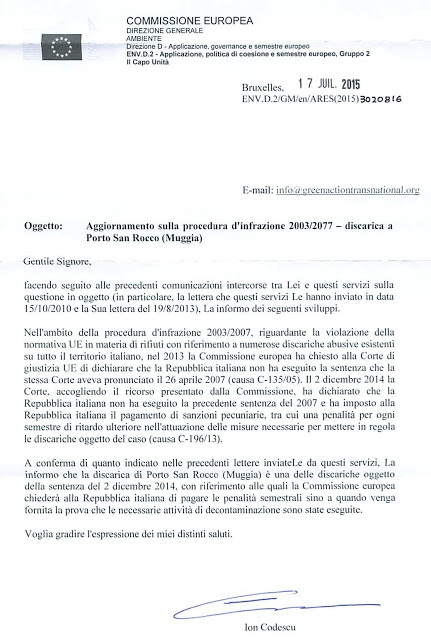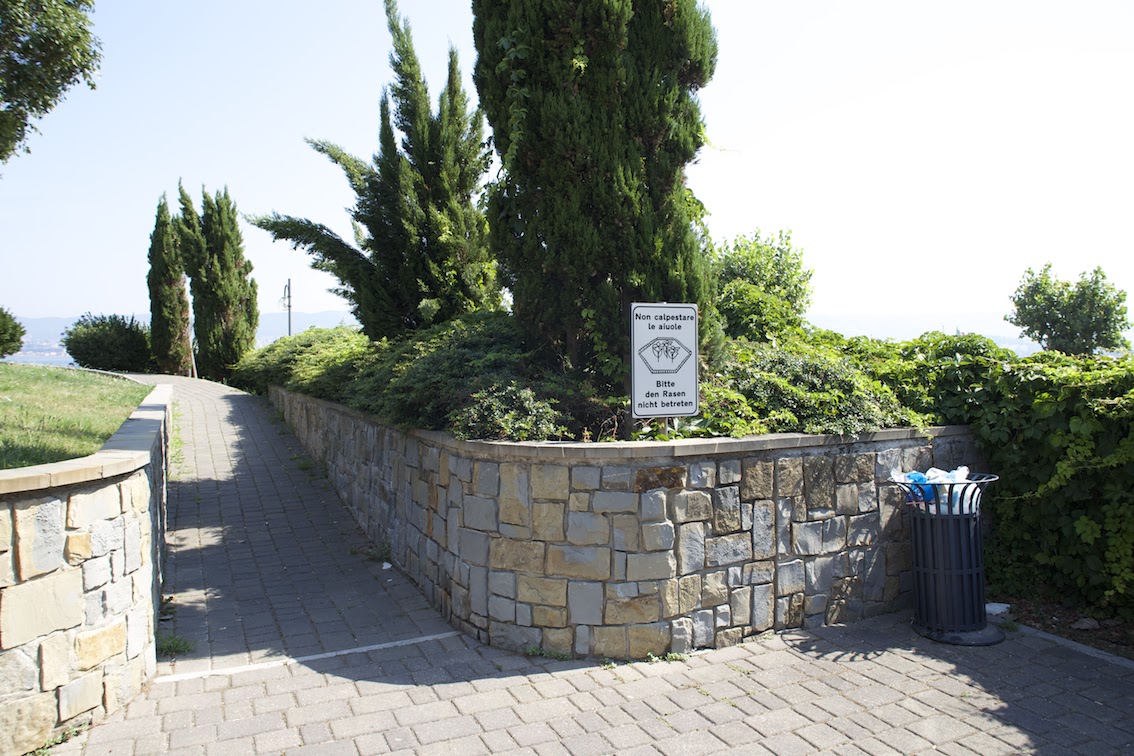| The entrance of the Parco delle Vele in Porto San Rocco: the European Court of Justice has ultimately sanctioned this landfill, disguised as a garden/playground. |
The European Court of Justice found Italy guilty for the landfill in Porto San Rocco (Muggia). This is an important turning point for the yet-unresolved question of environmental pollution in Trieste.
But it is also also a happy conclusion for an action in defense of the environment and of public health. An action that started a long time ago, by a small number of activists who stood against many.
The story of Porto San Rocco is perfect as an example of the struggles against the system of corruption that rules Trieste. It is a system fully supported by the authorities. And this makes it even harder defeating it. Harder than in the lands run by organized crime.
It’s been 12 years since I denounced the dangerous Porto San Rocco landfill: it only exists because of the local authorities. Porto San Rocco should have been a first class touristic marina.
Instead, it is one of many places chosen for the uncontrolled disposal of waste. In Trieste, the system responsible for so much pollution is active since a long time (at least since 1954, when the Italian Government became responsible of administering Trieste).
This is how the Porto San Rocco marina (Muggia) became the hiding place of toxic and hazardous waste. Poison in the bowels, houses, shops, docks, and parks on the surface. The surface of a huge, illegal landfill.
The “Parco delle Vele” (Sails park) is one such polluted areas. It is an artificial hill by the sea, and it hide s18,000 tons. of sludges: polychlorinated biphenyl, aromatic hydrocarbons, heavy metals.
A cocktail of deadly pollutants in a thin plastic sack (expected to remain watertight for a mere 10 years). This hill, a garden and playground for children, with a shore at its feet, is a crypt full of hazardous waste: disposing it legally was too expensive.
This is far from the last Porto San Rocco landfill. There is yet another, by the sea, on the border with Slovenia. It is the “Acquario” embankment (named after the company responsible for it). The “Acquario” contains toxic and hazardous waste, yet, there was a plan to build a seaside resort on its top (yes, right on top of a landfill).
Facing the Acquario there were (and there are) some of Trieste’s main mussel farms. Obviously, the ongoing dumping of hazardous waste has widely affected them. Including a huge quantity of deadly mercury.
I told the story of these dumping grounds and of the system of responsible for Trieste’s environmental disaster in book “Tracce di Legalità” (Tracks of Legality). The long, painful story of the activists who stood against the Italian ecomafias that, unbothered, keep contaminating Trieste.
When I denouncing the illegal, dangerous Porto San Rocco dumping grounds, the local judiciary committed me fro trial. The Public Prosecutor was Federico Frezza: in his opinion, my intervention was excessive. All I did was denouncing a serious public health risk.
On their side, those responsible of dumping the waste were all “saved”. They avoided prosecution. They were “blessed” with the declaration of their crime as time-barred: the Court of Trieste’s Judge of the Preliminary Investigations didn’t consider ongoing pollution as a sign of the crime’s continuation.
In Italy, ruling an environmental crime”time-barred” is the first step towards its cover-up. Indeed, local authorities, first in line the Municipality of Muggia, did nothing to reclaim the area which, regardless of criminal liability, was seriously polluted.
Instead, the Municipality of Muggia chose to let the dumping grounds be, but claimed these are compatible with both the environment and public health. Indeed some creative interpretation of laws on both matters.
Despite the local Italian authorities doing nothing about it, things changed quickly when I addressed EU authorities. The European Commission included the illegal Porto San Rocco landfills to infringement procedure no. 2003/2007 against Italy.
This was happening at the same time as I stood trial for denouncing to public opinion the landfill. In the end I was found not guilty, but the trial was a good chance to learn about the local Italian judiciary’s policy when it comes to pollution in Trieste. Never bother polluters, especially when they hide behind Italian nationalism.
Indeed, when talking about the environmental disaster that affects Trieste, not only it is very little known, but its international political implication are hard to explain. This problem is not about some small Italian province. This is a well-planned environmental crime against another State.
In the name of bordering Italy, and thanks to the collaboration of the servile local authorities, the 212 km² Free Territory of Trieste is now contaminated with hazardous waste.
This waste management served to “destroy” the enemy State. From the Karst, where hundreds of caves and doline were turned into landfills, to the sea, with the whole costal line (including the Free Port) filled with waste embankments and underwater landfills. For decades, the Territory of Trieste was a massive experimental laboratory for the disposal of the Italian institutional ecomafias’ waste. It is not surprising that those responsible for this aren’t thrilled to compensate those who suffered this awful pollution and are poisoned by it.
This is also why it is important establishing the liabilities for Trieste’s pollution on the international level, overcoming the local corrupt justice that, in the name of Italy, hides a thorny past and fears an uncertain future.
On December 2nd, 2014, the European Court of Justice (case C-196/13) found that Italy failed to comply with its obligations regarding waste disposal. One of the landfills involved is in Muggia: it is, of course, the Porto San Rocco landfill, “disguised” as a garden/playground. The European Commission ordered Italy to pay heavy sanctions until the polluted area is fully decontaminated.
It took 12 years struggling against a whole corrupt system to archive this result. A little step to free Trieste from pollution. A great result for whoever trusts legality still.
Translated from blog “Ambiente e Legalità” – “Environment and Legality” by Roberto Giurastante

The European Commission confirms to Greenaction Transnational that Porto San Rocco is heavily polluted: Italy has to decontaminate the area.

